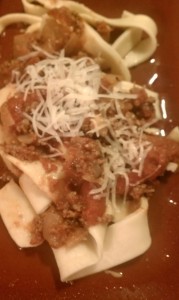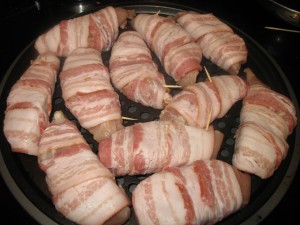Archive for December, 2011
For the start of the 2011 countdown we reach all the way back to February to recall Angry (Devil) Mussels.  These spicy crustaceans were great the first time around, but they made their way into the top ten because I couldn’t help making them a few more times throughout the year.
Before these guys showed-up at a roomate dinner, Fayaz swore he would never eat mussels; but after being tempted by spice and just a few he was taking them down just as fast as he could get ’em out their shell.  As cheap as they are easy to make, I can’t wait to cook-up some more in 2012.
As we reach the end of 2011, it’s time to look back and countdown the top 10 epicurean encounters of the year. Join me as I lay back, pat my stomach, and look back on a year of great food and drink.
While it seems like every two or three months a new restaurant pops-up in the South Slope–in a former bodega here, in a defunct shoe store there–8th Avenue is still by and large a culinary waste land.  So I was excited to see a restaurant in the works just two blocks from my apartment and waited with anticipation as it filled in a store front that has been vacant since I moved in to the neighborhood well over a year ago.
Then, one morning, on my way to the train, I saw that Giovanni’s Brooklyn Eats, complete with its shinny new neon sign, was open.  I excitedly grabbed a menu.  As I walked my excitement grew when I realized this new establishment was sporting a prefix brunch menu with all you can drink mimosas or bloody marrys.  But I could swear I’d seen it before.  As I scanned I realized that the menu was the same as Sette’s.  The same Sette at which I had a uniquely disappointing brunch experience several months ago.  Some internet researching revealed that this is in fact a reincarnation of the now closed Sette.
But this last weekend I was on the hunt for a brunch spot and thought I would give this Sette 2.0 a second chance.  It won’t be getting a third.  Giovanni’s presents a charming modern rustic interior.  But, as with the food, the appearance is where my appreciation ends.
As with Sette, the brunch food at Giovanni’s is remarkable only for its ability pack so little flavor into a beautifully presented plate.  I again tried the eggs Benedict.  This is a basic brunch dish, if it’s wrong it’s usually a sign the rest of menu will struggle.  None of the previous problems with this dish are solved in the new location.  The Hollandaise sauce is nothing more than a smear of orange on top of an admittedly well poached egg.  The ham acts as a salty condom ensuring that the delicious egg yolk  and sparse sauce doesn’t accidentally contact the hard bread base.  Though I did managed to get enough liquid under the ham to make one piece of bread edible.
The uovo al forno, an oven baked egg over polenta, tomato, and riccatt, was an uninspired, greasy, salty disappointment. Both who ordered this dish received over cooked eggs.  The real problem is that the tomato presented no flavor or freshness and nor did any other element to the dish.
On my visit to Sette I ran into serious server troubles–some of the worst service I’ve even encountered.  And, while the service was better at Giovanni’s, it still leaves much to be desire.  Our server wasn’t hostile or evasive, but it did at times take significant work to grab his attention and he never checked in on the table of his own accord.  My biggest disappointment was that, on exiting, I saw a sign outside describing the brunch and listing free coffee or tea as an element.  A fact that our server neglected to mention to this poor caffeine addicted soul.
I had strong hopes for Giovanni’s. Nothing would make me happier than having an awesome brunch place such a lazy distance from my front door. But it looks like the brunch gods want me to travel far and walk off my morning indulgences.
 I seem to only write about cooking successes here, filing the failures away as improvement projects to be blogged about when I figure out how to do things right.  In my defense I don’t have many out right failures.  That is to say it’s rare that I’ll cook something my roomies are unwilling to eat or that I’m unwilling to eat for lunch in the following days.  My Sunday pasta making endeavor falls into this minor failure category.
I seem to only write about cooking successes here, filing the failures away as improvement projects to be blogged about when I figure out how to do things right.  In my defense I don’t have many out right failures.  That is to say it’s rare that I’ll cook something my roomies are unwilling to eat or that I’m unwilling to eat for lunch in the following days.  My Sunday pasta making endeavor falls into this minor failure category.
Now, when I say pasta making, I don’t mean making a pasta sauce and boiling some boxed pasta. Â I mean making the pasta myself from flour, eggs, and salt. Â All without the benefit of a pasta maker.
All around this project was a bit of a disaster.  The first step involves making a mound of flour, with a hole in the middle that you fill with eggs into which you slowly incorporate the flour.  In theory.  My eggs overflowed their flour bowl; making the mixing process messy and awkward.  Next, I learned the value of a pasta maker.  Or, more accurately, I learned the pain of not having a pasta maker.  The pasta dough was elastic and fought against my efforts with the rolling pin.  I rolled the dough to what seemed like an adequate thinness and then cut the dough (using a pizza cutter) to what seemed like an adequate width. After dropping the raw pasta in its pot of boiling water and watching it expand, I realized I had made the pasta broth overly thick and wide.
Served with a Bolognese sauce, the flavor of the pasta seemed right.  But there was just too much of it. This stuff is dense.  Eating it required cutting a small piece and dredging it through the sauce.  Not a complete failure, but the stuff from the box would have been better.
Rather than sweeping this minor disappointment under the rug, I’m throwing it out as my first step in pasta making.  A pasta machine isn’t in my budget at the moment, so it will be more adventures in rolling pins for the foreseeable future.
Update: I re-heated this pasta for dinner 24 hours after storing it in the fridge covered in the Bolognese sauce.  The pasta seemed less dense and more approachable.  Actually pretty awesome.  I think I’m track here.  Once I figure out how to make a thinner noodle, I see some good eating in my future.
For the first time in my 29 Thanksgivings, I took the lead for this year’s day of culinary excess. Â Over the years, I’ve cooked a variety of T-day dishes. Â A sweet potato dish for the big day here, a Turkey for a work party there. Â But, before this November 24th, I never had to worry about the timing of it all at once and I’d never made real stuffing.
In order to ensure a moist turkey, I took the only path I know that doesn’t involve a deep fryer: brining.  It seems counterintuitive, but soaking a Turkey (or any meat for that matter) in a salt bath actual makes for a more moist bird.  I’m not a chemist, but the process allegedly involves osmosis–where the cells in the bird take on more water.  For a 13-15 pound turkey, use one and a half gallons of water and one and a half cups of kosher salt.  Combine the water and salt in a large pot, heat (to below a simmer), and stir until the salt is dissolved.  Then cool the pot in an ice bath or outside as Loren recently suggested.  The cooling is critical, otherwise you’ll be holding the turkey at a temperature idle for bacterial growth.  Once the brine has cooled immerse the turkey fully and set in the fridge for 24 to 36 hours.  You can immerse the turkey in either a large pot or in a large trash bag (it’s a good idea to triple layer if you go the bag route).  Prior to cooking, remove the turkey from the brine and put an herb butter mixture under the skin.  The herb butter will add some flavor and further moistness.  The end result?  An amazingly moist turkey.  Even days later the left overs are still moist.  I honestly don’t understand why everyone doesn’t brine their Thanksgiving turkey!
While the Turkey is the corner stone of thanksgiving dinner, everyone knows that the day is really about the sides.  So I pulled together some stuffing, a sweet potato dish, creamy garlic mashed potatoes, some fresh baked bread, and cranberry sauce.  Stu (the vegetarian) brought a nice big pan of mac’n cheese and Matt, in classic MN style, brought a pan of green bean casserole.  Iggy and her sister Heidi made a cucumber and sour cream salad.
The Stuffing
Since Stu is a vegetarian, I made both a meat and vegetarian version.  Both start the same way, with a few cups of celery and a few cups of yellow onion.  In a heavy bottom pot, cook the finely chopped celery and onion for approximately 15 minutes until soft and translucent.  For the meat version, I added in a few chopped chicken and apricot sausages.  Next I added about a cup of golden raisins that had soaked in warm water for about 20 minutes.   Next throw in a bunch bread crumbs and slowly mix in a few cups chicken stock (Stu let me do this for the “veggie” version as well) until the bread crumbs become soft, but not soaked.  At this point you can either stuff the turkey or bake in a baking dish.  Because oven space was at a high premium, I cooked the veggie batch on the stove in a dutch oven to create that crispy outside.
The Sweet Potatoes
This one requires a little planning.  The night before cooking  these you’ll need bake a couple sweet potatoes in the oven at 350 degrees for about 30 minutes, until they can be easily pierced with a knife.  Store in the fridge over night.  When it’s time to actually make the rest of the dish, skin the sweet potatoes and cut them into 1 inch slices.  Layer the slices sweet of potatoes with some crushed walnuts and canned sliced pineapple rings.  On the top, layer mini-marshmallows.  Bake covered for 15 to 20 minutes and then bake uncovered until the marshmallow begin to brown.
Cranberry Sauce
I had never made cranberry sauce before, but I was excited to try something new.  For some reason I had  visions of ginger cranberry sauce dancing in my head.  After finding a few recipes, I put a couple in to the following:
- One 16 ounce pack of cranberries
- One cup of water
- One cup of sugar (1/2 recommended for the future)
- One table spoon of ginger
- Zest of one orange
Also, while making my own cranberry sauce was fun, I still had to follow tradition and break out the canned stuff, served on a plate with can rings and all.
The Creamy Garlic Mashed Potatoes
Nick has made this dish a few times before and when it came time to select a mashed potato dish I knew that this one had to be it:
- 2 pounds russet potatoes
- 5 table spoons of butter
- 2/3 cups heavy cream
- One bulb of roasted garlic
Slice off the very top of the garlic head. Drizzle the head with olive oil and wrap in foil and bake at 400 for roughly 35 minutes. Remove from the oven and let cool.
Cut the potatoes into large pieces, making sure all are relatively the same size. Place the potatoes in a large pot, add the salt, and cover with water. Bring to a boil over medium-high heat and then reduce heat to maintain a rolling boil. Cook until potatoes are easily pierced with a fork. Meanwhile heat butter and cream until butter melts. Add the roasted garlic to the potatoes, mash all together, add the butter-cream mixture, and continue to mash until combined.  Serve immediately.
Warning: this dish is delicious AND incredibly filling.
The Meal
True to Thanksgiving tradition, after hours of prep and a day of cooking, everyone at the table was full beyond the ability to move in about 25 minutes.  After a movie break,ThanksKilling (a little known gem of a movie that was robbed at the Oscars), and picking at our plates as the first round of food settled, it was time for a little coffee and some great homemade apple and pumpkin pie.
All-in-all, I would say my first Thanksgiving cooking was a success.
Unlike many of my fellow Tundra inhabitants, I happen to enjoy living in Minnesota. I’ve got a 4×4 Jeep Cherokee (and a nice layer of insulation) to get me through the winter, fishing and swimming to get me through the summer, and hunting of all kinds to entertain me during the fall. Pheasant hunting is one of my favorite ways to spend a weekend. What could be better than a weekend with family, dogs and guns? Not to mention that because we spend all day walking the fields, we can justify having huge breakfasts with eggs, bacon and cornbread!
The weekend before Thanksgiving, I hit the fields with my brother Dan, my uncle Craig and my cousin’s husband, Ben. We had ourselves a grand old time and possibly our most bountiful harvest yet. There was one point where we let two pheasants get away because most of us were out of shells in our guns. But after the fun of actually hunting, you’re left with a lot of pheasant meat which can be very tricky to do well. I find that most of the time I have pheasant it turns out pretty dry, almost without regard to the manner in which it was cooked. So you can either serve it in stew, serve it with a rich gravy, or brine it. Having never tried that last option with a pheasant, that’s the way I decided to go and I may never go back again. The recipe for the brine is:
- 8 cups water
- 1/2 cup kosher salt
- 1 cup brown sugar
- 1/4 cup real maple syrup
- 1 onion, chopped
- 4 cloves garlic, smashed
- 1 tsp black pepper corns, whole
- 1-2 dashes of worcestershire sauce
- 1 pinch ground cloves (I used whole because that’s what I had)
- Juice of 1/2 lemon
- 1 dash cayenne pepper
Combine the water and the salt in a large pot, and heat it up on the stove until the salt dissolves. Then you need to cool of that liquid, so if you live in a similarly arctic environment just put the pot outside. Once it’s cool, bring it back inside and add all of the other ingredients, and the pheasant(s). I would imagine this could cover up to two whole pheasants as long as you separated the pieces, for me it was just enough to cover three large breasts. You’ll want to brine the pheasants for 8-12 hours. At this point, you can do all sorts of things with them. You can still roast it in the oven, bread it and fry it, whatever you like. But if you want dangerously good pheasant, read on…
Take the pheasant breasts and debone them. If you haven’t done this before, you’ll need a sharp knife and a good youtube video of deboning a whole chicken (skip to about 1:30). Now that you’ve got your boneless pheasant breasts, cut them diagonally in half. The point of the diagonal cut is that you don’t want one piece being short and fat while the other is long and thin or they obviously won’t cook evenly. Now pat the meat dry and toss with just a bit of olive oil and a sprinkling of some kind of seasoning. You could use cajun seasoning, garlic & herb, whatever, I used some chicago steak seasoning blend. Just remember to go easy on both things because excess olive oil is going to cause flares on the grill and 12 hours of brining kind of obviates the need for tons of seasoning on the outside of the bird.
Now’s when the real fun starts: you’ll need a pack of bacon! Wrap the pheasant breast sections in bacon, using toothpicks to hold everything together. If you can, try to hide at least one end of the toothpick in the meat so it doesn’t burn. You’ll probably need to move the meat around the grill quite a bit because the bacon fat will cause flareups and there’s pretty much nothing you can do about it. Just keep moving the pheasant so the meat doesn’t get scorched or covered in soot. Cook the meat to an internal temperature of 165 degrees then remove from the grill and let rest for 5 minutes or so.
sections in bacon, using toothpicks to hold everything together. If you can, try to hide at least one end of the toothpick in the meat so it doesn’t burn. You’ll probably need to move the meat around the grill quite a bit because the bacon fat will cause flareups and there’s pretty much nothing you can do about it. Just keep moving the pheasant so the meat doesn’t get scorched or covered in soot. Cook the meat to an internal temperature of 165 degrees then remove from the grill and let rest for 5 minutes or so.
So, why is this recipe dangerously good? Well, if you’ve never eaten game birds before there is one critically important thing which you must not forget: you may bite into a piece of shot at any time. Depending on the size of shot, that will be anywhere between the size of a peppercorn and a pin head but regardless of the size, it will hurt like a son of a bitch if you bite down on one. Because of that, you have to chew the meat very slowly and concentrate on feeling for any peices of shot. When I first made this recipe last weekend, the combination of the brined pheasant with the bacon flavoring and the smoke of the charcoal was such an amazing combination that I continually forgot that I needed to eat it slowly and just started scarfing. Try this recipe at your own risk!



